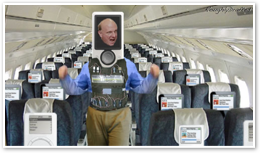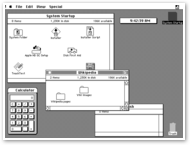





Here's a look at rival efforts to usher in a new computing platform in the early 1990's. IBM's OS/2 partnership with Microsoft intended to replace DOS with an advanced new PC software platform, while Microsoft’s own Windows hoped to prevent competition with other existing DOS vendors. The partners struggled to maintain control while faced with external competition and internal rivalry.
Later, a look at the rise of Microsoft's Windows; new partnerships between IBM and Apple to update Mac hardware and software; industry attempts to clone NeXT; a series of spectacular failures at Apple; and the rise of new, free options in the desktop platform world.
Along the way, clues emerge that help answer today’s questions about the upcoming battle between Leopard and Vista, the ongoing struggle of Linux and Windows, the game console war between Microsoft, Nintendo and Sony, and even the rivalry between Apple's iPod and Microsoft’s PlaysForSure and Zune.

Platform Death Match introduced the difficulty of launching a new platform and the work involved in maintaining one. This series looks at the historical march of computing platforms, to sort out why winners won and why losers lost. While the computing environment is always changing, the same basic rules are in effect today, and will shape the future developments between Mac OS X Leopard and Windows Vista.
Previous articles:

1990-1995: The Race to Deliver the Next New Platform
As personal computing moved into the 1990's, dramatic advances in hardware rapidly outpaced progress in operating system software.
The newly established graphical desktop was being taxed with additional complexity: multiple concurrent applications, multiple users, networking, expanded memory addressing, high resolution color graphics, and support for multiple monitors and larger hard drives. These all demanded a more sophisticated operating system.
Three consumer platforms from 1985-1990 that died in the early 1990s, the Apple IIGS, the Commodore Amiga, and the Atari ST, all employed innovative new hardware technology, but in many cases failed to fully deliver that potential using similarly advanced software support. 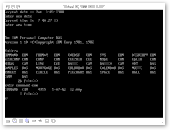

That left Apple's Macintosh and PCs running DOS as the mainstream state of the art in desktop computing. However, both were aging rapidly and needed either outright replacement or serious retrofitting.
In 1990, both Apple and PC makers were having no problem introducing faster and more powerful hardware, but on the software side, both DOS the Mac System Software began facing serious architectural problems that raised barriers for new operating system technologies able to take full advantage of the newest hardware.
OS/2: A Better DOS than DOS
Microsoft had been working with IBM on the successor to MS-DOS, called OS/2. However, it wasn't catching on, for the same reason that DR-DOS and other alternative PC operating systems hadn’t made much progress since 1980-1985: they all had to compete against the entrenched sales of MS-DOS.
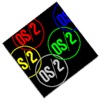

Even though Windows was simply running on top of the same DOS and PC hardware that were already an established standard, Windows represented a new platform because it required entirely new applications to take advantage of its features.
Microsoft's efforts to get PC users to adopt Windows on their existing hardware was proving about as difficult as Apple's efforts to migrate Apple II users to the entirely new Mac.
Notable platform lesson: Software can be as significant of a barrier to new platform adoption as new hardware.
Not Too Fast
In addition to competing against its own MS-DOS with Windows, Microsoft also faced risks in pushing OS/2 too hard as a new platform; too much focus on the future might allow the minority DOS vendors, such as DR-DOS and others, to hijack control of the direction of the existing DOS PC platform.
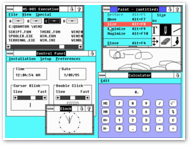 By stealing enough of Microsoft's DOS market share, these competitors might derail the momentum building behind OS/2 before the new system could gain traction. That would result in a death spiral for Microsoft; existing sales would stall, and future sales would never materialize.
By stealing enough of Microsoft's DOS market share, these competitors might derail the momentum building behind OS/2 before the new system could gain traction. That would result in a death spiral for Microsoft; existing sales would stall, and future sales would never materialize.That risk to Microsoft’s software platform would be similar to IBM's earlier 1985-1990 PC hardware platform crisis, when the PC was cloned from underneath IBM before its PS/2 could establish a new replacement platform.
Notable platform lesson: Remaining the big fish is only possible if you can resist being overwhelmed by smaller parasites.
Benevolent Dictator Platforms vs. Anarchy Platforms
Microsoft had to be conservative with its efforts to establish OS/2 because they did not own the entire platform. If Microsoft and IBM had maintained complete ownership of the PC, they could more easily decree the direction of DOS, and simply present OS/2 as the new product everyone would use.
Instead, Microsoft's software focus was torn between DOS, DOS/Windows, and OS/2, while IBM’s hardware was being eaten alive in the PC desktop market by cloners. No one entity really controlled the PC market, and that anarchy was retarding its progress and development, particularly in software, but also in the area of hardware and software integration.
Apple faced the same set of growing pain issues, but its complete ownership of the Mac platform allowed it more freedom to pioneer new technologies, and expect users and developers to adopt its new conventions more rapidly. In the second half of the 80's, Apple had shipped five new major versions of the Mac System Software; by 1990, it was at System 6 and completing System 7.
Notable platform lesson: Platform ownership makes advancements easier to deliver to users.
However, just like DOS, the Mac system software was beginning to run out of steam. How did Apple try to adapt, and what different issues did it face as the owner of an entire platform? Stay tuned for the next installment.
This Series

| | Comment Preview
 Read more about:
Read more about:

 Send |
Send |

 Subscribe |
Subscribe |
 Del.icio.us |
Del.icio.us |
 Digg |
Digg |
 Furl |
Furl |
 Reddit |
Reddit |
 Technorati
Technorati
Click one of the links above to display related articles on this page.
1990-1995: The Race to Deliver The Next New Platform
Wednesday, September 6, 2006






Ad




